

We’ve all said it. We’ve all used it as a selling tool. We’ve all explained to people the processes and equipment that we use to repair a vehicle back to “pre-accident condition.”
We’ve all been optimistically, yet totally, wrong in using this term to describe the types of repairs we make.
Like a mirage out in a scorching desert, we’ve explained repairs this way and may have even believed it from time to time. But like all mirages, it just isn’t there, and repeating the phrase over and over again until it’s engrained into the collision repair business isn’t going to make it a reality.
It usually starts like this: “Good afternoon ma’am. How can I assist you today?”
“Well, I’ve been involved in a terrible accident. This truck ran a red light and didn’t even hit his brakes. I bet he was doing 70 miles an hour!”
“Wow, were you injured?”
“No. My rear fender was smashed and my bumper is loose, but I wasn’t hurt.”
“Well, ma’am, it’s good news that you weren’t injured, but let’s go and look at your vehicle to see how badly it was hurt.”
“Young man, my only concern is that my vehicle won’t be the same as it was before the wreck. I plan on this vehicle being the last one I have to buy, and I’m really worried it won’t drive right.”
“Ma’am, I understand your concerns, but let me assure you that with the modern equipment and products we now use in the repair business, we’ll repair your vehicle to ‘PRE-ACCIDENT CONDITION.’ ”
Unwittingly, you’ve just told this little old lady an untruth.
You may be the best collision repair facility this side of the Mississippi. You may have invested in a $65,000 frame machine, a computerized laser measuring system that’s accurate to .2 mm, a state-of-the-art downdraft spraybooth and a resistance spot welder that can nearly duplicate a factory spot weld. You may send all of your techs to every I-CAR class that’s taught in your community, and they may all be ASE Master Collision & Refinish Technicians. You may provide them with the finest tools that can be bought off of a truck. You may use corrosion protection to isolate repair areas and do a complete detail for each and every customer. You may employ a quality assurance tech to verify quality repairs through each stage of the repair process. You may have done all of this, and you still cannot and should not use the term “pre-accident condition.”
It just isn’t accurate.
How did we get to this point in the collision repair business? Let’s take a look at our history …
There was a time when repairing a vehicle was done by serious craftsmen, and it still is today in some locations. Legends of watching a guy “work the lead” are still being told over morning coffee in shops around the country.
Times changed, and we then moved into caking filler into dents the size of softballs and pulled ladder frames by using an “Oak-A-Liner.”
The repairs were solid, and they served the purpose of making the vehicle useable again. Sometimes it even drove straight. Yeah, you could see that it was repaired, but so what? We understood back then that it was repaired. We had done some work to it, and it didn’t look like it drove off the showroom floor. The repairs were good — they just weren’t invisible.
We’re an industry that’s begun believing its own press.
Here we are today — an industry that’s begun believing its own press. In today’s consumer-driven economy where there’s a higher demand by vehicle owners and insurance companies, we’ve allowed ourselves to be led down the wrong road.
At some point, when faced with questions about whether a vehicle repaired at our shops will look and perform the same as it did before the accident, some of us started saying “Uh, yeah. Sure it will — pretty much.”
Then, in an effort to differentiate our shops from other shops, we elaborated: “We have the equipment, tooling and training to repair your vehicle back to factory specs. As a matter of fact, it will look and perform as well as it did before the accident. I guess you could say we can repair it back to ‘pre-accident’ condition.”
The genie was out of the bottle, and there was no putting it back in.
Now the phrase is used almost universally to describe the majority of industry-acceptable repairs.
The fact is, the shops I’ve been involved with didn’t have a robot welder spotting in near-perfect spot welds. There were no zinc baths to dunk whole vehicles in to ensure corrosion protection. No automatic robotic spray paint machines to assure a uniform pattern and a dead-on color match. None of the locations were $559 million super-facilities that employed 1,500 workers — each assigned to very specific tasks.
No, they were just collision repair facilities.
I’ve worked in and been associated with some of the most technologically advanced facilities, but I still never should have let the words “pre-accident condition” leave my mouth.
Anyone who’s ever done re-inspections or quality-assurance reviews can almost always tell if and where a vehicle was repaired. Any auction writer or wholesale broker worth his salt can pick out the vehicles that have been repaired. With the use of mirrors, paint mill gauges and computerized measuring devices, the veil has been lifted.
We’re fortunate that a large percentage of the public isn’t as savvy as they think they are.
Could we repair vehicles in a way that would make it very difficult to discover the repair? Absolutely! Many shops do that every day. But many times, we’ve allowed outside parties to back us into corners.
We’ve all dealt with insurance companies that demand a faster, more “cost effective” (i.e. cheaper) repair. They also cut repair hours, penalize us for vehicles that run past specified repair days and demand the use of LKQ/used or aftermarket parts.
How can we be expected to do all of this and get vehicles back to how they were before they were wrecked?
The answer may be quite simple. I have a good friend and excellent instructor who now works with me, and he used the simplest analogy when explaining the repair process to adjustors.
When asked why a vehicle didn’t look perfect and hadn’t been repaired to “pre-accident condition,” Tommy would stick his finger in the air. There, on his right index finger, was a slight scar from a tool or some event that occurred years before.
He would direct the adjustor’s attention to that scar and say: “Do you see that scar? This finger was injured years ago. Lots of blood, it hurt like hell and I had to go to the doctor to get it sewed up. He did a damn good job of fixing my finger. It doesn’t hurt anymore, I have no loss of motion and I use it every day. But every day I see the scar. It never bothered me because I knew that I had done something stupid that resulted in it being there. I could have gotten rid of the scar. I could have gone to a plastic surgeon who would have charged me thousands of additional dollars to minimize an already minimal blemish on my finger. But I paid for a doctor, not a plastic surgeon.”
So in your future dealings with insurers, feel free to use Tommy’s story to drive home your point. Just make sure you stick up the right finger.
Writer Randy Trahan is the director of collision and reconditioning training at Manheim, which includes paint and body instruction and training, as well as condition report writing, estimating, NAAA frame instruction and soft skills training associated with both the collision and reconditioning divisions of Manheim. He also runs the Manheim Technical Center and manages the three instructors attached to it.













